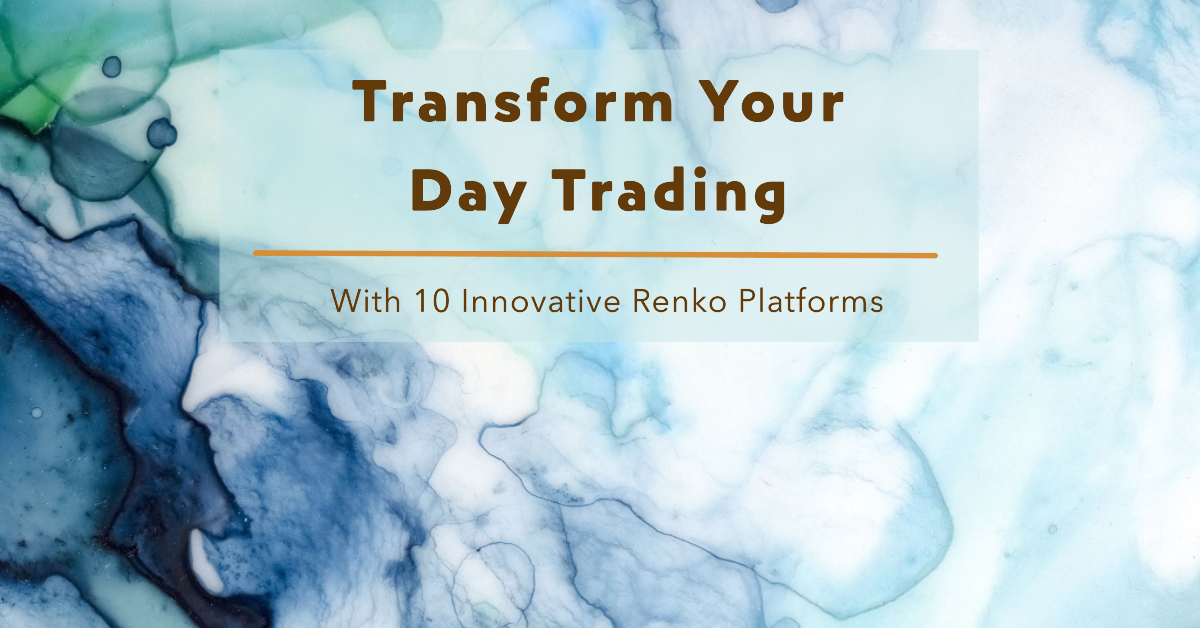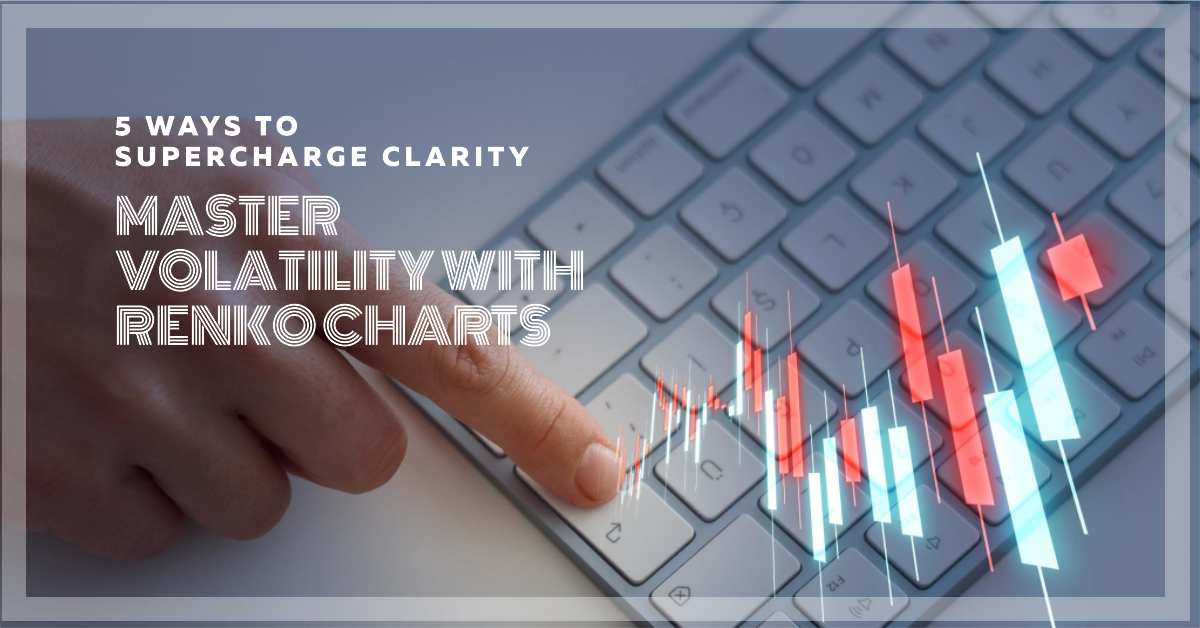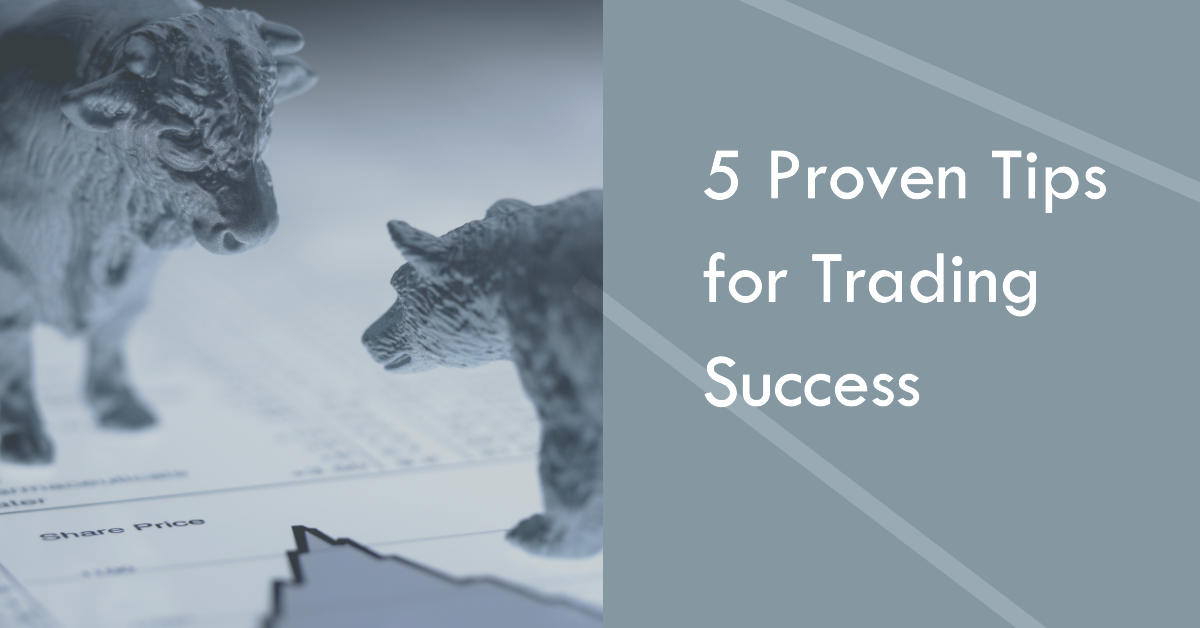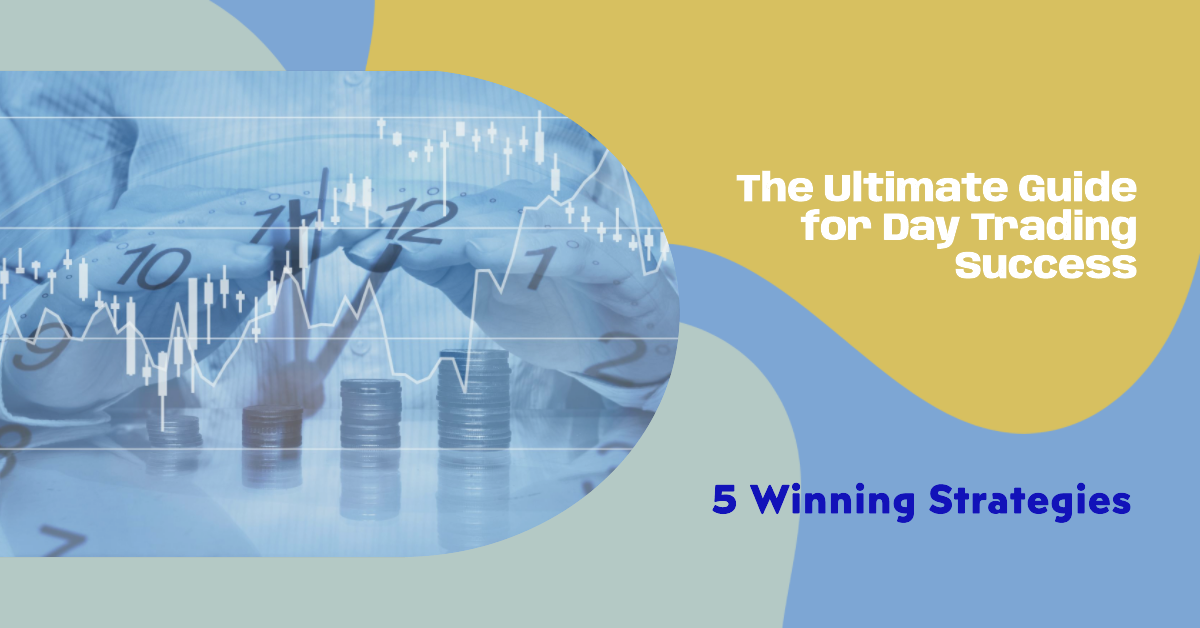Table of Contents
Renko charts have gained significant popularity among day traders due to their ability to provide clearer trends and reduce market noise. If you’re looking to enhance your day trading strategies using Renko charts, you’re in luck. In this article, we’ll explore 10 innovative day trading platforms that offer robust Renko charting capabilities. These platforms are designed to revolutionize the way you analyze and execute trades, helping you achieve better results in your day trading journey.
1. Introduction to Renko Chart Day Trading
Renko charts, a lesser-known charting technique compared to traditional candlestick charts, have been making waves in the day trading world. Unlike candlestick charts that rely on time intervals, Renko charts focus solely on price movement. Each Renko “brick” represents a fixed price movement, and new bricks are only added to the chart when the price surpasses the brick size. This approach filters out market noise, making it easier to identify trends and crucial support and resistance levels.
Renko charts offer several advantages for day traders. For instance, they provide a clearer visualization of trends, making it easier to spot trend reversals and trend continuation patterns. This can greatly assist traders in making well-timed entries and exits. Additionally, Renko charts eliminate the irregularities caused by price gaps or small price fluctuations, offering a smoother representation of price movement.
Example: Imagine you’re trading a volatile cryptocurrency like Bitcoin. Traditional candlestick charts might show multiple small candlesticks due to rapid price fluctuations, making it hard to discern the overall trend. On the other hand, a Renko chart would filter out these small movements, presenting a more coherent trend direction.
2. Mastering Renko Chart Patterns for Day Trading Success
Renko chart patterns play a pivotal role in helping traders anticipate potential price movements and make informed trading decisions. Let’s explore some of the key Renko chart patterns that traders should master for day trading success.
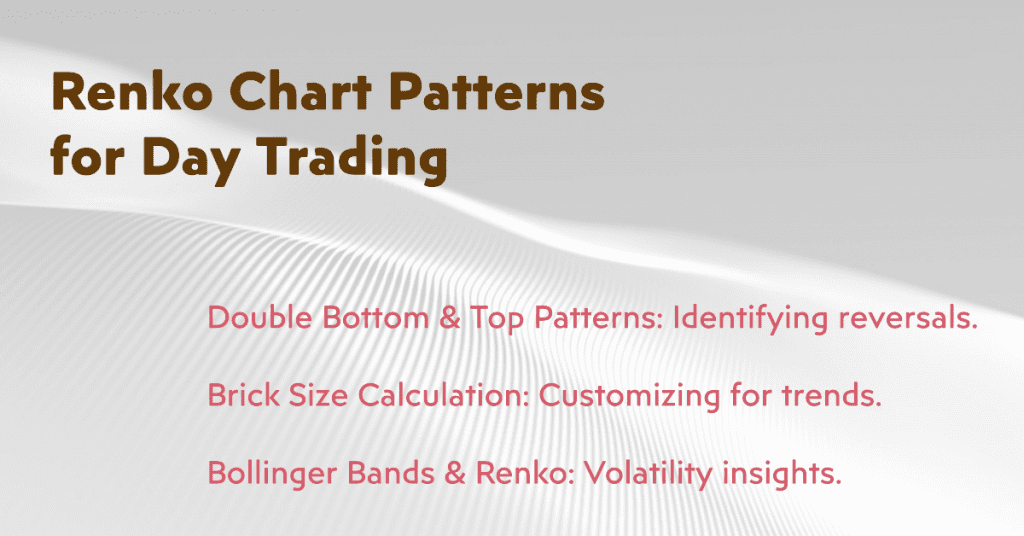
1. Double Bottom and Double Top Patterns:
A double bottom pattern consists of two consecutive troughs that are roughly at the same level, indicating a potential bullish reversal. Conversely, a double top pattern consists of two consecutive peaks at a similar level, signaling a possible bearish reversal. Renko charts can provide a clear representation of these patterns, helping traders identify trend reversals more accurately.
Example: Imagine a cryptocurrency has formed a double bottom pattern on a Renko chart. The first trough is followed by a bullish brick, and the subsequent trough forms at a similar price level. This pattern suggests that buying interest is entering the market, potentially leading to an upward price movement.
Example: Let’s say you’re analyzing a stock that has been exhibiting a double bottom pattern on Renko charts. Traditional charts might not provide a clear view of this pattern due to minor price fluctuations. However, with Renko charts, you can easily spot the distinct double bottom formation, allowing you to plan your entry more confidently.
2. Brick Size Calculation for Patterns:
Renko charts allow traders to customize the brick size based on the price movements they want to capture. The brick size influences the appearance of patterns and the sensitivity of the chart. Smaller brick sizes might help traders capture minor price fluctuations, while larger brick sizes emphasize significant trends.
Example: A trader analyzing a stock with high volatility might opt for a larger brick size, such as $2. This choice could help them focus on the broader price trends rather than short-term volatility.
Use Case: Trading with Bollinger Bands and Renko Charts
Bollinger Bands are a popular technical indicator used to measure volatility and identify potential overbought or oversold conditions. When combined with Renko charts, Bollinger Bands can offer valuable insights into price volatility and potential trend reversals.
Suppose a trader is using Renko charts to analyze a cryptocurrency. By overlaying Bollinger Bands on the Renko chart, they can identify periods of increased volatility when the price movements breach the bands. This information can aid in timing entries or exits and adjusting trading strategies to changing market conditions.
Unveiling Renko Chart Patterns: A Comprehensive Overview
3. Comparing Different Day Trading Platforms: Features and Benefits
When it comes to day trading using Renko charts, the platform you choose plays a crucial role in your success. Each trading platform comes with its own set of features, tools, and benefits that can significantly impact your trading experience. In this section, we’ll take an in-depth look at 10 innovative day trading platforms that offer Renko charting capabilities. We’ll analyze their unique attributes, charting tools, and the advantages they bring to the table.
MetaTrader 4 (MT4)
MetaTrader 4, or MT4, is a renowned trading platform widely used by traders around the world. It offers Renko charts through custom indicators, allowing traders to integrate Renko charting seamlessly into their strategy. Various Renko chart indicators have been developed specifically for MT4, providing traders with the flexibility to choose the one that suits their preferences.
Pros:
- Wide user base and community support.
- Customizable indicators for Renko chart analysis.
- Multiple timeframes available for Renko charts.
Cons:
- Limited features compared to more advanced platforms.
- Steeper learning curve for beginners.
MetaTrader 5 (MT5)
MetaTrader 5, the successor to MT4, offers an enhanced trading experience with more advanced features. Similar to MT4, MT5 provides Renko charting options through custom indicators and scripts.
Pros:
- Improved features and capabilities compared to MT4.
- Availability of Renko chart indicators.
- Support for additional markets and instruments.
Cons:
- Transition from MT4 to MT5 may require some adaptation.
- Limited number of brokers offer MT5 compared to MT4.
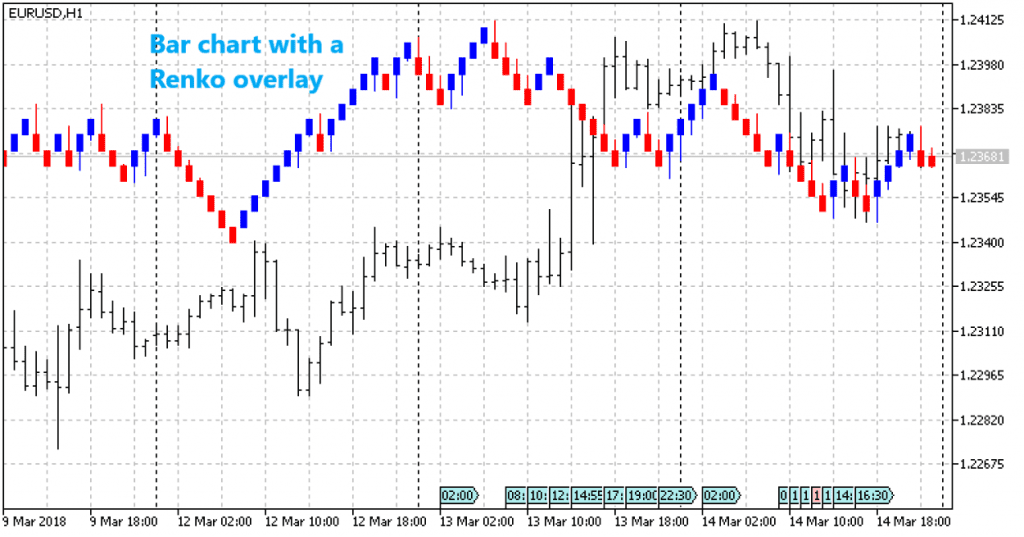
Renko 2.0 – indicator for MetaTrader 5
NinjaTrader
NinjaTrader is a popular trading platform known for its versatility and third-party indicator support. It allows traders to access Renko charts either through built-in features or by using third-party indicators available on its platform.
Pros:
- Extensive library of third-party indicators, including Renko charts.
- Advanced order execution capabilities.
- Robust backtesting and optimization tools.
Cons:
- Some indicators may come with additional costs.
- Platform fees for live trading.
Thinkorswim
Thinkorswim, offered by TD Ameritrade (now part of Charles Schwab), is a comprehensive trading platform that caters to traders seeking advanced charting capabilities. Renko charts are among the unique charting options available on this platform.
Pros:
- Advanced charting tools including Renko charts.
- Paper trading and analysis capabilities.
- Access to a wide range of markets and assets.
Cons:
- Complex interface for beginners.
- TD Ameritrade’s commission structure.
TradingView
TradingView is a widely used web-based platform known for its extensive charting tools and strong community engagement. Renko charts are part of the diverse charting options provided by this platform.
Pros:
- User-friendly interface and social community features.
- Customizable charts with various technical indicators.
- Collaborative environment for sharing trading ideas.
Cons:
- Some advanced features require a subscription.
- Limited backtesting capabilities.
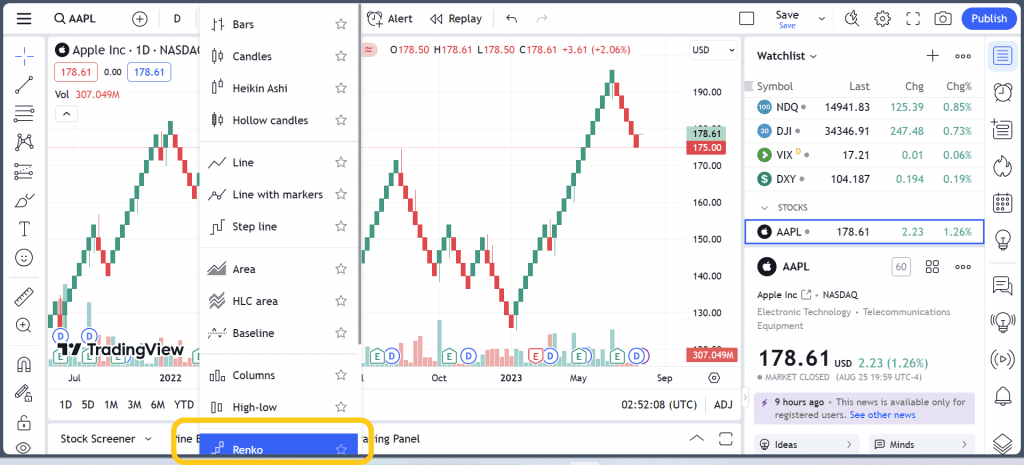
MultiCharts
MultiCharts is a professional trading platform favored by experienced traders. It supports Renko charting along with a range of other advanced chart types. This platform is notable for its backtesting and optimization capabilities.
Pros:
- Advanced backtesting and strategy development features.
- Support for multiple data feeds and brokers.
- Renko charting integrated with professional trading tools.
Cons:
- Higher learning curve for beginners.
- Costly compared to some other platforms.
Sierra Chart
Sierra Chart is a comprehensive trading platform that provides Renko charts along with advanced technical analysis and trading features. It’s designed for traders who require sophisticated tools for in-depth analysis.
Pros:
- In-depth technical analysis capabilities.
- Integration of Renko charts with advanced features.
- Reliable data feed options.
Cons:
- Complex interface for beginners.
- Less user-friendly compared to some other platforms.
cTrader
cTrader is a trading platform that offers Renko charts and caters to both beginner and advanced traders. It focuses on user-friendly design and customizable features, making it suitable for traders of varying skill levels.
Pros:
- Intuitive and user-friendly interface.
- Customizable charting options, including Renko charts.
- Algorithmic trading capabilities.
Cons:
- Limited third-party indicators compared to some platforms.
- Smaller community compared to larger platforms.
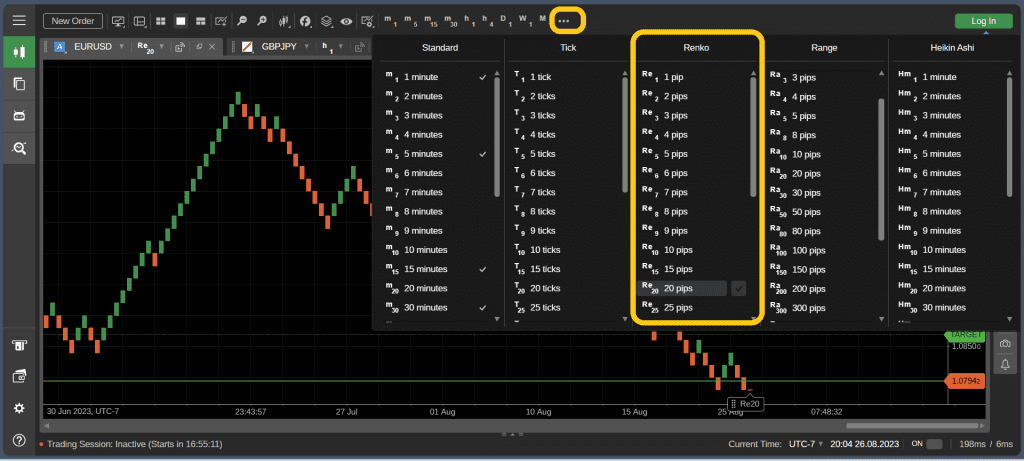
ATAS (Advanced Time And Sales)
ATAS is designed for order flow analysis and advanced charting, including Renko charts. This platform is ideal for traders looking to gain insights into market dynamics through detailed analysis.
Pros:
- Focus on order flow analysis and market dynamics.
- Renko charts with unique visualization tools.
- Suitable for both beginner and experienced traders.
Cons:
- Specialized focus may not appeal to all traders.
- Limited community compared to broader platforms.
TradeStation
TradeStation offers Renko charting alongside its suite of trading tools. It’s known for its analytical capabilities and automation options, making it suitable for traders who rely on data-driven strategies.
Pros:
- Robust analytical tools and indicators.
- Integration of Renko charts with advanced analysis.
- Automation capabilities for strategy execution.
Cons:
- Higher costs compared to some other platforms.
- Steeper learning curve for beginners.
Comparing these 10 innovative day trading platforms reveals a range of features and benefits tailored to different trader preferences. The key is to consider your trading style, technical analysis needs, and comfort level with platform interfaces. By selecting the platform that aligns with your requirements, you can effectively harness the power of Renko charts to enhance your day trading strategies.
4. Choosing the Best Day Trading Platform for Renko Chart Analysis
As a day trader focusing on Renko charts, selecting the right trading platform is a critical decision. The following platforms stood out in our comparison due to their unique features tailored for Renko chart analysis:
- MetaTrader 5 (MT5): Building on the success of MT4, MT5 offers enhanced features and flexibility. With the ability to run multiple timeframes of Renko charts simultaneously, MT5 allows traders to analyze trends comprehensively. Its support for custom indicators and scripts ensures a dynamic trading experience.
- NinjaTrader: Known for its advanced trading capabilities, NinjaTrader offers in-built Renko charting features. Traders can customize brick sizes and chart styles to suit their preferences. Additionally, NinjaTrader’s ecosystem of third-party indicators and strategies provides a wide range of tools for Renko chart analysis.
- TradingView: TradingView’s intuitive interface and social interaction make it a favorite among traders. Its Renko charts come with a selection of customization options. With a vast library of community-contributed indicators and the ability to share ideas, TradingView fosters a collaborative trading environment.
- Sierra Chart: Offering Renko charts as part of its comprehensive toolset, Sierra Chart is favored by advanced traders. Its extensive technical analysis tools, support for custom studies, and trading functionality make it a powerhouse for Renko-based strategies.
- ATAS (Advanced Time And Sales): Geared towards order flow analysis, ATAS integrates Renko charts to provide insights into market dynamics. It offers unique features like the Volume Profile, allowing traders to identify significant price levels on Renko charts.
Best Day Trading Platforms for Renko Chart Analysis
| Platform | Features | Pros | Cons |
|---|---|---|---|
| MetaTrader 5 (MT5) | Multiple Renko chart timeframes, custom indicators | Enhanced features, flexibility | Learning curve for beginners, programming skills needed |
| NinjaTrader | Customizable brick sizes, third-party indicators | Advanced capabilities, wide tool range | Overwhelming for beginners, additional purchases |
| TradingView | Intuitive interface, community indicators | User-friendly, collaborative environment | Limited free features, subscription needed for advanced |
| Sierra Chart | Technical analysis tools, custom studies | Comprehensive analysis, custom studies support | Not beginner-friendly, utilitarian design |
| ATAS (Advanced Time And Sales) | Order flow analysis, Volume Profile on Renko charts | Focus on order flow, unique Volume Profile | Specialized, less known among traders |
While these platforms excel in Renko chart analysis, the choice ultimately depends on your trading style, preferences, and budget. Consider factors like ease of use, additional features, and integration with other tools, such as backtesting capabilities and algorithmic trading support.
5. Top Strategies for Renko Chart Day Trading
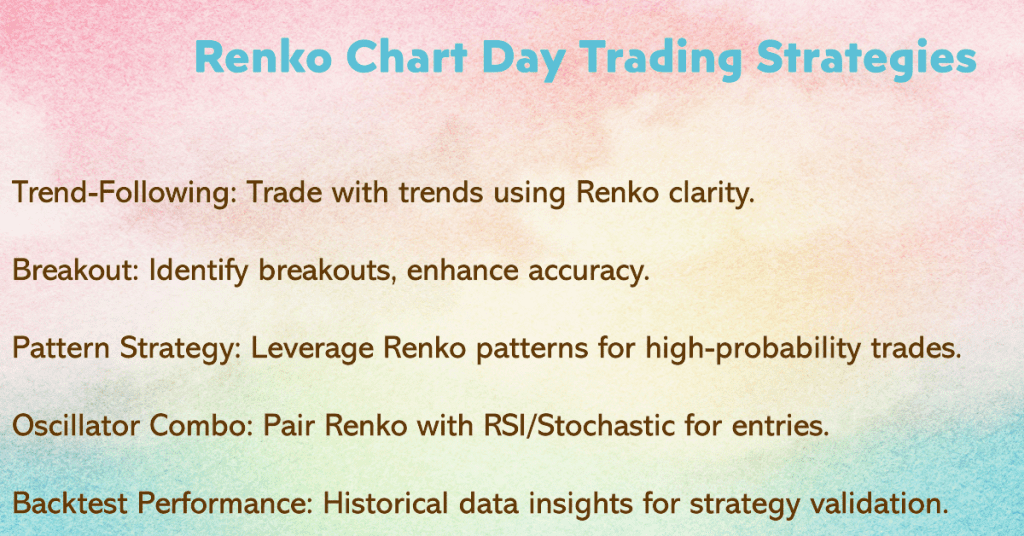
Once you’ve selected a suitable platform, it’s time to explore effective day trading strategies that align with Renko charts:
- Trend-Following Strategy: Renko charts excel in identifying trends. A trend-following strategy involves trading in the direction of the established trend. Traders can use moving averages, trendlines, and price patterns on Renko charts to confirm trend direction and enter trades with the momentum.
- Breakout Strategy: Renko charts can provide clearer breakout signals by filtering out noise. Traders can look for significant price levels and wait for a breakout above or below these levels. Bollinger Bands and ATR-based thresholds can enhance the accuracy of breakout signals.
- Renko Chart Patterns Strategy: Leveraging Renko chart patterns discussed earlier, traders can capitalize on patterns like double bottoms, tops, and Heikin Ashi crossovers. These patterns, when confirmed with other technical indicators, can offer high-probability trading opportunities.
- Combining Renko with Oscillators: Oscillators like Relative Strength Index (RSI) and Stochastic can be used alongside Renko charts to identify potential overbought or oversold conditions. When these conditions align with a Renko trend reversal pattern, it can lead to effective trade entries.
Backtesting these strategies on historical data within your chosen platform can provide insights into their performance. This step is crucial to understand the strategy’s profitability, win rate, and drawdown before implementing it in live markets.
Renko and Indicators Synergy: 5 Dynamic Strategies for Trading Success
6. Utilizing Automation: Day Trading Platforms with Algorithmic Trading Support
Algorithmic trading, also known as automated trading or algo trading, involves using computer programs to execute trades based on predefined conditions. Several platforms in our comparison offer algorithmic trading capabilities alongside Renko charts. Here’s how automation can enhance your Renko-based strategies:
- Efficiency: Automation eliminates the need for manual execution of trades. This can be especially advantageous for Renko strategies that require quick responses to price movements.
- Emotion Management: Emotions can negatively impact trading decisions. Automation enforces discipline by executing trades based solely on programmed conditions, reducing the influence of emotions.
- Backtesting and Optimization: Algorithmic trading platforms often include backtesting and optimization tools. Traders can test their Renko-based strategies on historical data to fine-tune parameters and improve performance.
- 24/7 Trading: Algorithmic trading operates round the clock, enabling you to capture trading opportunities even when you’re not actively monitoring the markets.
Backtesting Renko Chart Strategies: Tips and Techniques
However, it’s essential to approach algorithmic trading with caution. Over-optimization, technical glitches, and market anomalies can impact the performance of automated strategies. Regular monitoring and periodic adjustments are necessary to ensure the effectiveness of automated Renko strategies.
7. Risk Management and Renko Chart Day Trading
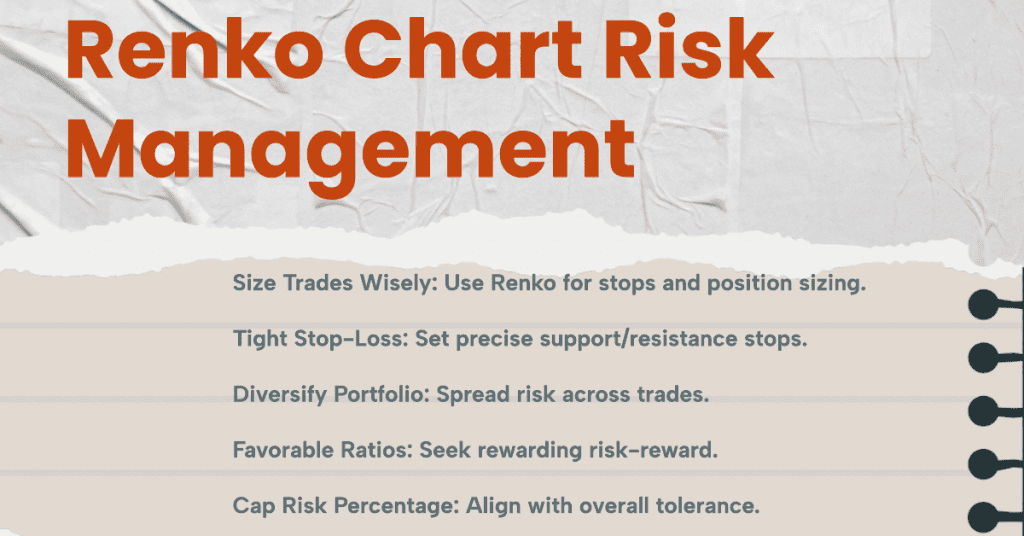
While the innovative platforms and strategies can enhance your Renko chart day trading, effective risk management remains the cornerstone of success. Here’s how you can manage risks while trading with Renko charts:
- Position Sizing: Determine the appropriate size for each trade based on your risk tolerance and account size. Renko charts can help you identify suitable stop-loss levels and calculate position sizes that align with your risk management strategy.
- Stop-Loss Orders: Set tight stop-loss orders to limit potential losses. Renko charts can help you define precise support and resistance levels for placing stop-loss orders, reducing the impact of market noise.
- Portfolio Diversification: Avoid putting all your capital into a single trade. Diversify your trading portfolio across multiple instruments and strategies to mitigate the impact of a single trade gone wrong.
- Risk-Reward Ratio: Ensure that your potential reward justifies the risk you’re taking. A favorable risk-reward ratio, such as 1:2 or higher, can help you maintain profitability even if not all trades are winners.
- Risk Percentage: Determine the maximum percentage of your trading capital you’re willing to risk on a single trade. This percentage should align with your overall risk tolerance and account size.
By incorporating these risk management practices into your Renko-based trading strategy, you can protect your capital and navigate the challenges of the market more effectively.
8. Pros and Cons of Day Trading
Day trading, including Renko chart day trading, comes with its own set of advantages and disadvantages:
Advantages:
- Quick Profit Potential: Day trading aims to capitalize on short-term price movements, offering the potential for quick profits.
- Active Engagement: Day traders remain engaged with the markets throughout the trading session, which can lead to a better understanding of market dynamics.
- Flexibility: Day trading doesn’t require overnight holds, providing traders with the flexibility to adjust to changing market conditions.
Disadvantages:
- High Risk: Day trading involves significant risk due to the frequency of trades and potential for losses.
- Emotional Stress: The fast-paced nature of day trading can lead to emotional stress, affecting decision-making.
- Time-Intensive: Day trading requires constant monitoring of the markets, which can be time-consuming.
9. Comparing Day Trading, Short Term Investing, and Long Term Investing
To provide a holistic perspective, let’s compare day trading with short-term investing and long-term investing:
Day Trading: Involves frequent trades within a single trading day. It offers quick profit potential but requires active engagement and a strong understanding of market dynamics. It suits individuals who can dedicate time to trading and manage the associated risks.
Short-Term Investing: Involves holding positions for a few days to a few weeks. It provides a balance between active engagement and time commitment, suitable for traders who prefer less frequent trades.
Long-Term Investing: Involves holding positions for months or years. It’s less time-intensive and allows for a more hands-off approach. Long-term investors focus on fundamental analysis and the growth potential of assets.
Comparing Trading and Investing Approaches
| Approach | Definition | Examples | Pros | Cons |
|---|---|---|---|---|
| Day Trading | Frequent trades within a day | Quick stock flips, crypto trading | Quick profits, active engagement | High risk, constant attention |
| Short-Term Investing | Holding for days to weeks | Swing trading, sector ETFs | Potential gains, less intense | Still volatile, research needed |
| Long-Term Investing | Holding for months to years | Blue-chip stocks, real estate | Compounding, less stress | Slow returns, subject to shifts |
Conclusion
By harnessing the power of Renko charts and utilizing the capabilities of the 10 innovative platforms mentioned earlier, you can transform your day trading experience. Whether you’re a seasoned trader or just starting out, integrating Renko charts into your strategy can provide a unique perspective on price trends and patterns. Remember to thoroughly understand the strategies you implement, practice disciplined risk management, and choose a trading style that aligns with your goals and risk tolerance.
With the right approach and tools, Renko chart day trading can become a valuable addition to your trading toolkit, helping you navigate the complexities of the financial markets and work towards your trading objectives.
